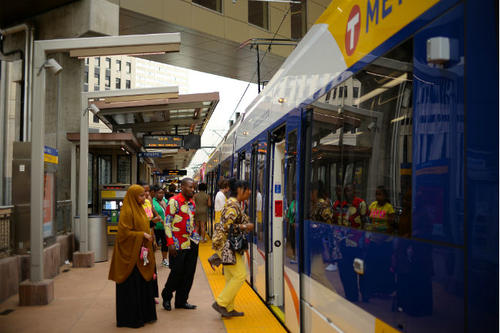
According to a new University of Minnesota study, the mismatch between unemployed workers and job vacancies is a serious problem in the Twin Cities region and it appears to have worsened since the turn of the millennium. The biggest concentrations of unemployed workers lack fast or frequent transit service to some of the richest concentrations of job vacancies, particularly vacancies in the south and southwest metro.
The new study analyzes such employment mismatches in the Twin Cities seven-county metropolitan area and examines the potential of a new approach that integrates transit planning and workforce development.
“Transit plays a crucial role in connecting the unemployed with job opportunities, but it could be even more effective if efforts to get the unemployed to those job vacancies were better coordinated with efforts to give them the skills they need for those job vacancies,” said principal investigator Yingling Fan, who conducted the study with research fellow Andrew Guthrie. “Our research lays out an approach to reconcile those mismatches by coordinating transit planning, job training and job placement services.”
Disadvantaged job seekers often may be qualified for many entry-level jobs but have no way of reaching employment centers, which frequently are in the suburbs. What’s more, these job seekers may be able to reach many nearby jobs easily but lack needed qualifications.
Efforts to address these mismatches often focus on transportation—such as improved or specialized public transit services—and skill-building and occupational training programs. Policymakers have generally separated the two.
“The Twin Cities region is in the midst of major expansion of the transit system and it will have consequences in terms of travel patterns and development patterns for decades,” Fan said. “That allows coordinated job training and transit planning efforts to make a big, long-lasting impact.”
The research team's policy recommendations center on finding “sweet spots” for coordinated transit planning and workforce development and creating a future transit system to serve the needs of disadvantaged workers.
A key element of the study involves GIS maps developed by the researchers showing the concentrations of the unemployed, overlaid with patterns of job vacancies, for the entire region, between 2001 and 2013. They compared transit-accessible job vacancies for specific occupations to determine mismatch patterns.
For example, a band of cities with the highest job vacancies in manufacturing—jobs that have comparatively lower educational requirements—surround Minneapolis to the west and north. The highest concentrations of unemployment, however, are in Minneapolis and St. Paul.
The team then developed multiple transit planning, job creation, and workforce development policy scenarios, generating similar maps for each.
The study was sponsored by Hennepin County, the Jay and Rose Phillips Family Foundation of Minnesota, and the McKnight Foundation.
“McKnight Foundation focuses on our low-income people and places that have been left out of the picture previously. Dr. Fan’s research pulls these areas together so policy-makers can see how policy can connect, reinforce, support, and provide benefit to the people that we care about,” said Eric Muschler, program director with the McKnight Foundation.
Fan, an associate professor with the University of Minnesota Humphrey School of Public Affairs, collaborates with the Center for Transportation Studies as a faculty scholar. CTS is nationally renown for developing, fostering, and spreading innovation in transportation.
More about this research, including a two-page research brief and the full research report, is available at cts.umn.edu/research/featured/transitandworkforce.
- Categories:
- Science and Technology





